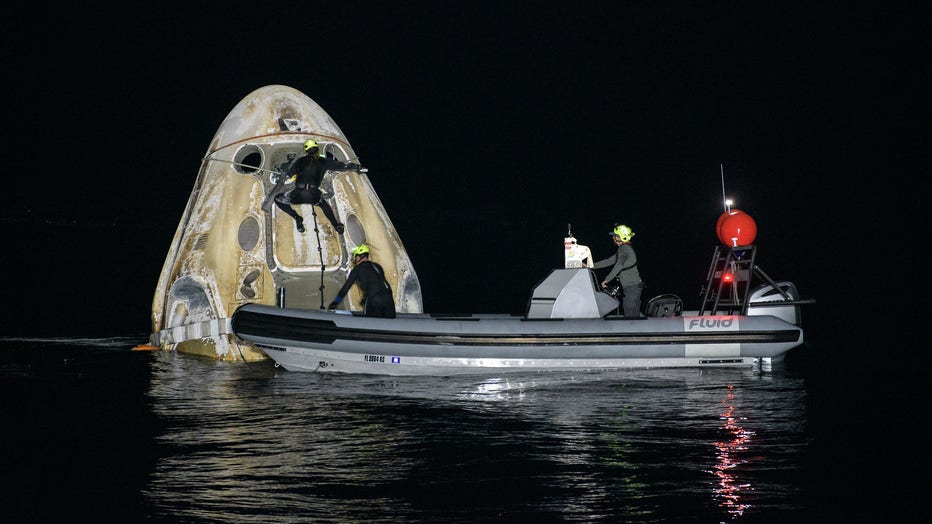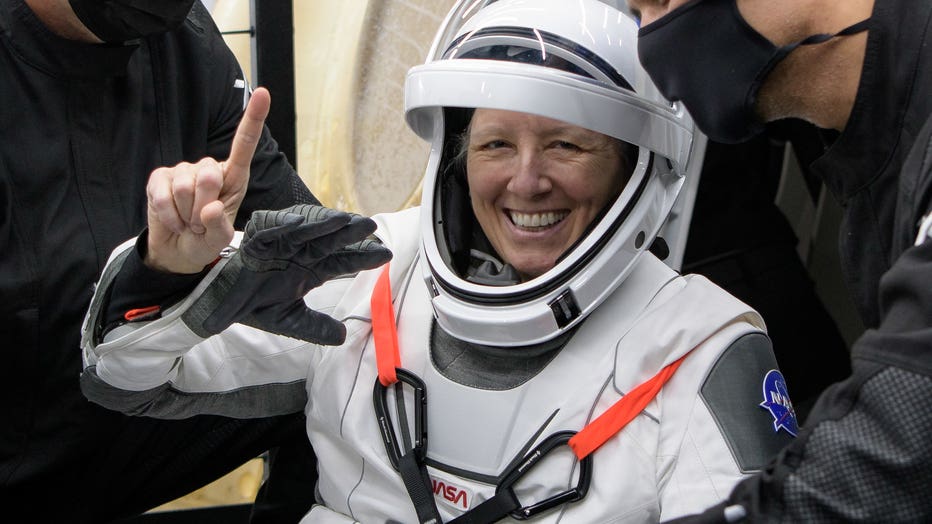SpaceX Crew Dragon 'Resilience' completes 1st nighttime splashdown
SpaceX Crew Dragon ‘Resilience’ completes first nighttime splashdown
After departing from the International Space Station the night prior, SpaceX Crew-1 returned safely to Earth very early on Sunday morning.
CAPE CANAVERAL, Fla. - SpaceX safely returned four astronauts from the International Space Station on Sunday, making the first U.S. crew splashdown in darkness since the Apollo 8 moonshot.
The Dragon capsule parachuted into the Gulf of Mexico off the coast of Panama City, Florida, just before 3 a.m., ending the second astronaut flight for Elon Musk’s company.
It was an express trip home, lasting just 6 1/2 hours.
The astronauts, three American and one Japanese, flew back in the same capsule — named Resilience — in which they launched from NASA’s Kennedy Space Center in November.
Return of the SpaceX Crew-1 Astronauts Aboard
The SpaceX Dragon Crew Capsule Resilience successfully splashed down in the Gulf of Mexico near Panama City at approximately 2:57 a.m. EDT.
MORE NEWS: Florida ex-Sen. Bill Nelson confirmed as next NASA administrator
"We welcome you back to planet Earth and thanks for flying SpaceX," SpaceX’s Mission Control radioed moments after splashdown. "For those of you enrolled in our frequent flyer program, you’ve earned 68 million miles on this voyage."

Photo from NASA
"We’ll take those miles," said spacecraft commander Mike Hopkins. "Are they transferrable?"
SpaceX replied that the astronauts would have to check with the company’s marketing department.
Within a half-hour of splashdown, the charred capsule — resembling a giant toasted marshmallow — had been hoisted onto the recovery ship, with the astronauts exiting soon afterward.
NASA and SpaceX managers marveled at how fast and smooth the operation went. The company’s senior adviser, Hans Koenigsmann, said "it looked more like a race car pit stop than anything else."
Return of the SpaceX Crew-1 Astronauts Aboard
SpaceX Crew Dragon Resilience is lifted out of the water during recovery operations, about 30 minutes after splashdown.
Hopkins was the first one out, doing a little dance as he emerged under the intense spotlights.
MORE NEWS: Reported space debris threat to Crew Dragon capsule shines light on space pollution
"It’s amazing what can be accomplished when people come together," he told SpaceX flight controllers at company headquarters in Hawthorne, California. "Quite frankly, you all are changing the world. Congratulations. It’s great to be back."
The 167-day mission was the longest for a crew capsule launching from the U.S. The previous record of 84 days was set by NASA’s final Skylab station astronauts in 1974.
While in orbit, the team members of Crew-1 conducted several experiments, including growing vegetables in orbit, using microbes to mine minerals, simulating the effects of medicines in space, and looking at how the lack of gravity affects human brain function.
Saturday night’s undocking left seven people at the space station, four of whom arrived a week ago via SpaceX.
Crew-2 now aboard the International Space Station
There are now 11 people onboard the International Space Station after Crew-2 arrived early Saturday morning.
"Earthbound!" NASA astronaut Victor Glover, the capsule’s pilot, tweeted after departing the station. "One step closer to family and home!"
RELATED: PHOTOS: SpaceX Crew-1 astronauts back on Earth after splashdown
Hopkins and Glover — along with NASA’s Shannon Walker and Japan’s Soichi Noguchi — should have returned to Earth last Wednesday, but high offshore winds forced SpaceX to pass up a pair of daytime landing attempts. Managers switched to a rare splashdown in darkness, to take advantage of calm weather.

Photo from NASA

Photo from NASA

Photo from NASA

Photo from NASA

Photo from NASA
SpaceX had practiced for a nighttime return, just in case, and even recovered its most recent station cargo capsule from the Gulf of Mexico in darkness. Infrared cameras tracked the capsule as it re-entered the atmosphere; it resembled a bright star streaking through the night sky.
All four main parachutes could be seen deploying just before splashdown, which was also visible in the infrared.
Apollo 8 — NASA’s first flight to the moon with astronauts — ended with a predawn splashdown in the Pacific near Hawaii on Dec. 27, 1968. Eight years later, a Soviet capsule with two cosmonauts ended up in a dark, partially frozen lake in Kazakhstan, blown off course in a blizzard.
MORE NEWS: Elon Musk says ‘bunch of people will probably die’ during Mars mission
That was it for nighttime crew splashdowns — until Sunday.
Despite the early hour, the Coast Guard was out in full force to enforce an 11-mile (18-kilometer) keep-out zone around the bobbing Dragon capsule. For SpaceX’s first crew return in August, pleasure boaters swarmed the capsule, a safety risk.
Once finished with their medical checks on the ship, the astronauts will hop on a helicopter for the short flight to shore, then catch a plane straight to Houston for a reunion with their families.
"It’s not very often you get to wake up on the space station and go to sleep in Houston," chief flight director Holly Ridings told reporters.
Their capsule, Resilience, will head back to Cape Canaveral for refurbishment for SpaceX’s first private crew mission in September. The space station docking mechanism will be removed, and a brand new domed window put in its place.
MORE NEWS: SpaceX sends another batch of Starlink satellites into orbit
A post-splashdown news briefing was held by NASA and SpaceX on Monday morning.
NASA, SpaceX hold Crew-1 post-splashdown briefing
SpaceX has successfully completed the first U.S. splashdown of returning astronauts in darkness since the Apollo 8 moonshot in 1968.
"Today went very well overall, I'd say almost flawlessly," said NASA’s Steve Stich, "Dragon did great. It was great to hear the crew when they woke up, first thing Mike Hopkins did was ask what's the weather going to be like and we told him maybe 2 knots of wind and a foot of waves, and he was excited from the very beginning."
Launch administrators said during the briefing that they will take all the lessons learned from this and apply them to future missions to the space station and beyond.
"On the NASA side, we're going to take this learning into our future crew missions with Boeing, and most importantly the Artemis missions. I know the SpaceX folks are just going to keep doing these missions. I don't know how you could have done this one much better," said NASA’s Kathy Lueders.
RELATED: What's next? SpaceX private flight, Crew-3, Artemis mission, more
A tech billionaire has purchased the entire three-day flight, which will orbit 75 miles above the space station. He’ll fly with a pair of contest winners and a physician assistant from St. Jude Children’s Research Hospital, his designated charity for the mission.
SpaceX’s next astronaut launch for NASA will follow in October.
NASA turned to private companies to service the space station, after the shuttle fleet retired in 2011. SpaceX began supply runs in 2012 and, last May, launched its first crew, ending NASA’s reliance on Russia for astronaut transport.
RELATED: 2 space fans get seats on billionaire's private SpaceX flight
Boeing isn’t expected to launch astronauts until early next year.
Tune in to FOX 35 Orlando for the latest Central Florida news.

